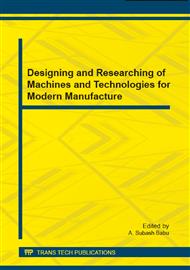[1]
C. Pearson, and R. Parkins, The extrusion of metal, Chapman & Hall ltd., London, pp.223-270, (1960).
Google Scholar
[2]
Y.F. He, S.S. Xie, L. Cheng, FEM simulation of aluminum extrusion process in porthole die with pockets, Trans. Nonferrous Met. Soc. China. 20 (2010) 1067-1071.
DOI: 10.1016/s1003-6326(09)60259-4
Google Scholar
[3]
G. Fang, J. Zhou, J. Duszczyk, Effect of pocket design on metal flow through single-bearing extrusion dies to produce a thin-walled aluminium profile, J. Mater. Process. Technol. 199 (2008) 91-101.
DOI: 10.1016/j.jmatprotec.2007.08.033
Google Scholar
[4]
A. Promsawan, S. Dechjarernand S. Pitakthapanaphong, Study of effects of pocket die dimension on velocity in extrusion of aluminum 6063, Proceeding of the conference 19th ME-nett, Phuket, Thailand, (2005).
Google Scholar
[5]
S. Kalpakjian, and S.R. Schmid, Manufacturing Processes for Engineering Materials, Prentice Hall, pp.307-319, (2008).
Google Scholar
[6]
Y.T. Kim, K. Ikeda, T. Murakami, Metal flow in porthole die extrusion of aluminum, J. Mater. Process. Technol. 121 (2002) 107−115.
Google Scholar
[7]
R.K. Uyyuru, H. Valberg, Physical and numerical analysis of the metal flow over the punch head in backward cup extrusion of aluminum, J. Mater. Process. Technol., 172 (2006) 312−318.
DOI: 10.1016/j.jmatprotec.2005.09.024
Google Scholar
[8]
B.P.P.A. Gouveia, J.M.C. Rodrigues, P.A.F. Martins, N. Bay, Physical modeling and numerical simulation of the round-to-square forward extrusion, J. Mater. Process. Technol. 112 (2001) 244−251.
DOI: 10.1016/s0924-0136(01)00725-7
Google Scholar
[9]
J.X. Xie, K. Ikeda, T. Murakami, UBA analysis of the process of pipe extrusion through a porthole die, J. Mater. Process. Technol. 49 (1995) 371−385.
DOI: 10.1016/0924-0136(94)01582-l
Google Scholar
[10]
M.K. Sinha, S. Deb, U.S. Dixit, Design of a multi-hole extrusion process , Materials & Design, 30(2) (2009) 330−334.
DOI: 10.1016/j.matdes.2008.04.062
Google Scholar
[11]
F.K. Chen, W.C. Chuang, S. Torng, Finite element analysis of multi-hole extrusion of aluminum-alloy tubes, J. Mater. Process. Technol., 201(1/3) (2008) 150−155.
DOI: 10.1016/j.jmatprotec.2007.11.292
Google Scholar
[12]
J. Lof, Y. Blokhuis, FEM simulations of the extrusion of complex thin-walled aluminum sections, J. Mater. Process. Technol. 122 (2002) 344−354.
DOI: 10.1016/s0924-0136(01)01266-3
Google Scholar
[13]
P. Zhi, T. Sheppard. Simulation of multi-hole die extrusion. Materials Science and Engineering: A, 367(1/2) (2004) 329−342.
DOI: 10.1016/j.msea.2003.10.294
Google Scholar
[14]
P. Ulysse, Extrusion die design for flow balance using FE and optimization methods, Mechanical Sciences, 44 (2002) 319−341.
DOI: 10.1016/s0020-7403(01)00093-5
Google Scholar
[15]
Prachprayoon P., Extrusion Die Design Using Finite Element Method, Proceeding of the conference 21th ME-nett, Chonburi, Thailand, (2007).
Google Scholar


